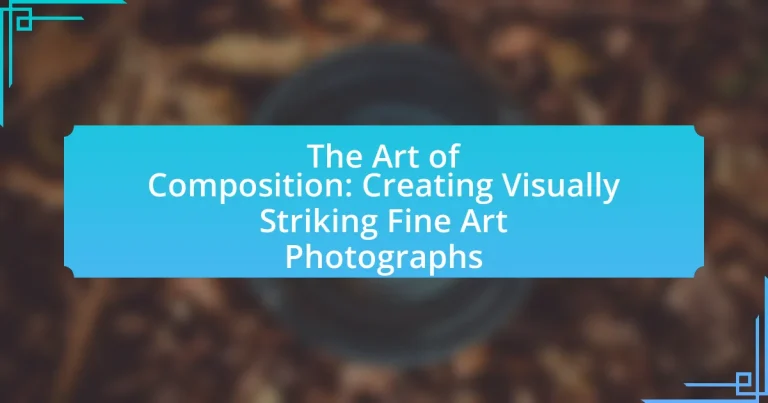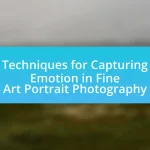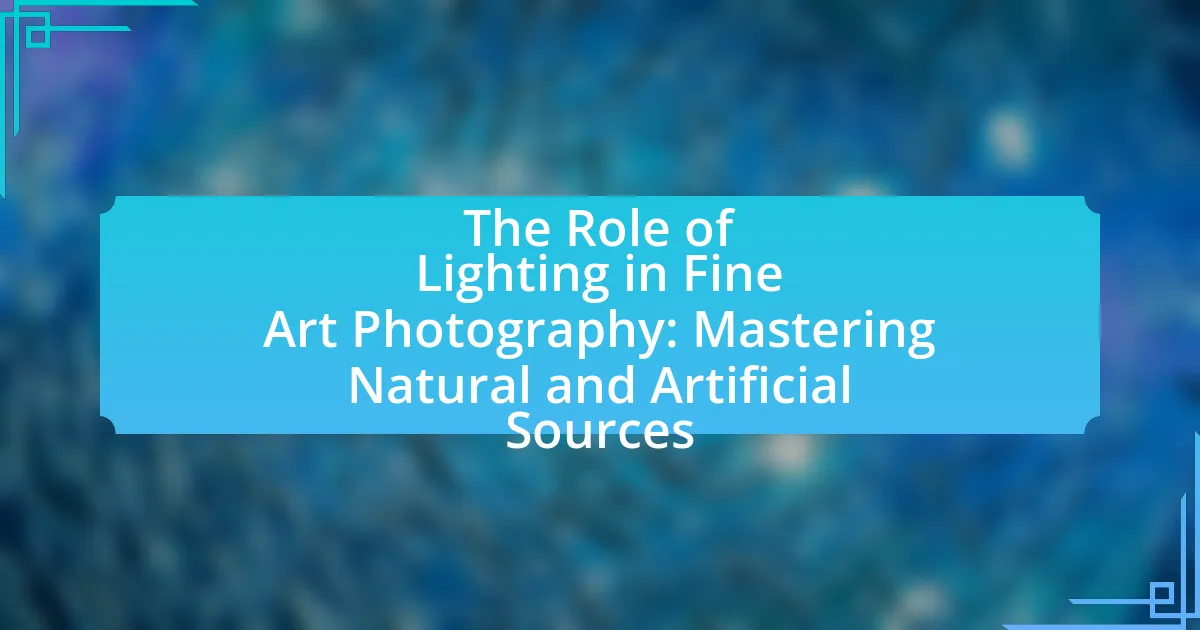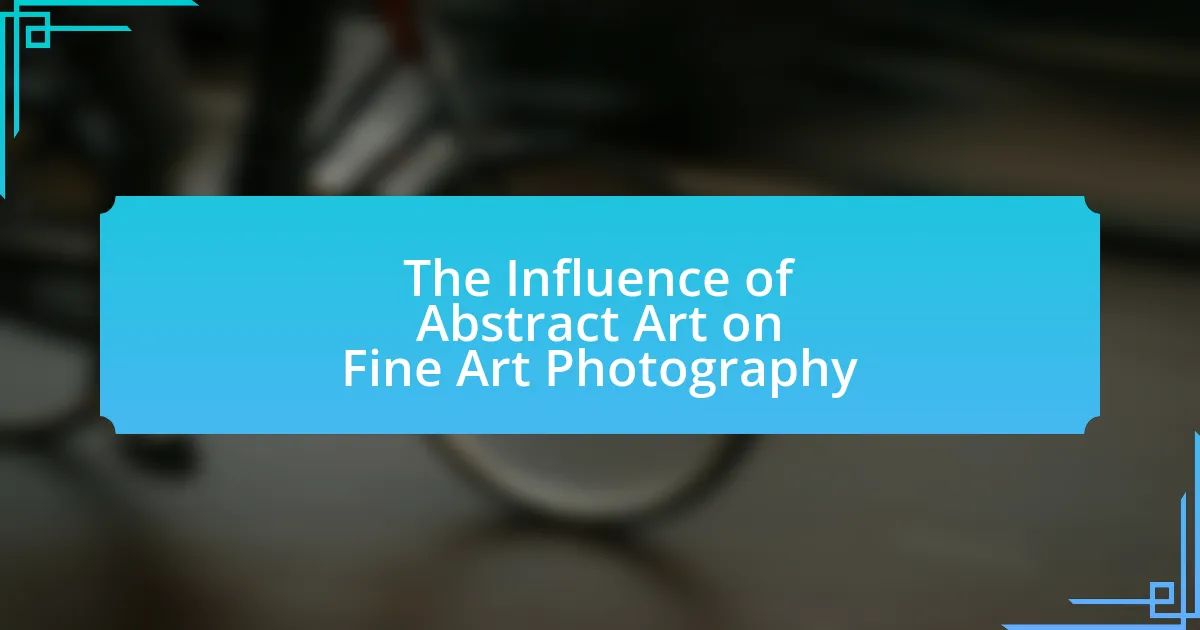The article focuses on “The Art of Composition: Creating Visually Striking Fine Art Photographs,” emphasizing the importance of composition in photography. It outlines fundamental principles such as the rule of thirds, leading lines, and balance, which guide the viewer’s eye and enhance emotional engagement. The article also discusses how different compositional techniques influence viewer perception, the role of color and light, and practical exercises for improving compositional skills. Additionally, it highlights common mistakes to avoid and best practices for achieving a cohesive visual narrative, ultimately underscoring the significance of effective composition in fine art photography.
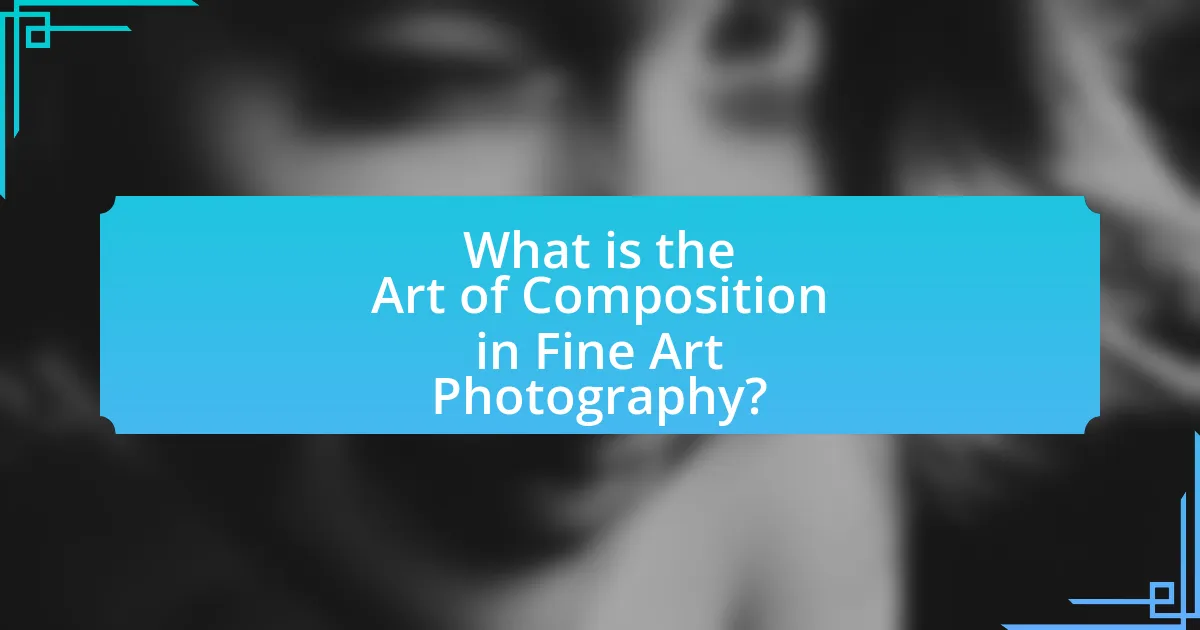
What is the Art of Composition in Fine Art Photography?
The Art of Composition in Fine Art Photography refers to the deliberate arrangement of visual elements within a photograph to create a harmonious and impactful image. This involves principles such as balance, contrast, leading lines, and the rule of thirds, which guide the viewer’s eye and evoke emotional responses. Effective composition enhances the narrative and aesthetic quality of the photograph, making it more engaging. Studies in visual perception indicate that well-composed images are more likely to capture attention and convey meaning, underscoring the importance of composition in fine art photography.
How does composition influence the visual impact of photographs?
Composition significantly influences the visual impact of photographs by determining how elements are arranged within the frame. Effective composition guides the viewer’s eye, creates balance, and establishes a focal point, which enhances the overall aesthetic appeal. For instance, the rule of thirds, a fundamental compositional technique, suggests dividing the image into a grid and placing key elements along these lines or their intersections, resulting in a more dynamic and engaging photograph. Studies in visual perception indicate that well-composed images are more likely to capture attention and evoke emotional responses, reinforcing the importance of composition in photography.
What are the fundamental principles of composition in photography?
The fundamental principles of composition in photography include the rule of thirds, leading lines, framing, symmetry, and balance. The rule of thirds suggests dividing the frame into a grid of nine equal parts and placing key elements along these lines or at their intersections to create visual interest. Leading lines guide the viewer’s eye through the image, enhancing depth and perspective. Framing involves using elements within the scene to create a ‘frame’ around the subject, drawing attention to it. Symmetry creates a sense of harmony and balance, while balance ensures that visual weight is distributed evenly across the composition. These principles are widely recognized in photography and are essential for creating visually striking images.
How do different compositional techniques affect viewer perception?
Different compositional techniques significantly influence viewer perception by guiding attention, evoking emotions, and establishing context. Techniques such as the rule of thirds create balance and focus, leading viewers to engage more deeply with the subject. For instance, placing key elements along the grid lines can enhance visual interest and create a sense of harmony, as supported by studies in visual perception that show viewers are naturally drawn to these focal points. Additionally, techniques like leading lines direct the viewer’s gaze through the photograph, creating a narrative flow that enhances storytelling. Research by the American Psychological Association indicates that composition can affect emotional responses, with well-composed images eliciting stronger feelings of connection and engagement. Thus, the application of compositional techniques is crucial in shaping how viewers interpret and emotionally respond to fine art photographs.
Why is composition essential for creating striking fine art photographs?
Composition is essential for creating striking fine art photographs because it determines how elements within the frame interact and guide the viewer’s eye. Effective composition utilizes principles such as the rule of thirds, leading lines, and balance to create visual interest and emotional impact. Research by the National Geographic Society indicates that well-composed images are more likely to engage viewers, as they create a sense of harmony and focus. This engagement is crucial in fine art photography, where the intent is often to evoke feelings or provoke thought, making composition a fundamental aspect of the art form.
What role does composition play in storytelling through photography?
Composition is crucial in storytelling through photography as it determines how elements within the frame interact to convey a narrative. Effective composition guides the viewer’s eye, emphasizes focal points, and creates a sense of balance or tension, all of which enhance the emotional impact of the image. For instance, the rule of thirds can be employed to position key subjects in a way that draws attention and evokes a specific response, while leading lines can direct the viewer’s gaze through the scene, creating a journey within the photograph. Studies in visual perception indicate that well-composed images are more likely to engage viewers and elicit emotional reactions, reinforcing the importance of composition in visual storytelling.
How can effective composition enhance emotional responses in viewers?
Effective composition enhances emotional responses in viewers by guiding their attention and evoking specific feelings through visual elements. Techniques such as the rule of thirds, leading lines, and framing create a structured visual narrative that resonates emotionally. For instance, a photograph that uses leading lines can draw the viewer’s eye toward a focal point, creating a sense of journey or tension. Research indicates that well-composed images can trigger emotional reactions; a study published in the journal “Emotion” found that viewers rated images with strong compositional elements as more emotionally impactful compared to poorly composed images. This demonstrates that effective composition not only captures attention but also deepens emotional engagement.
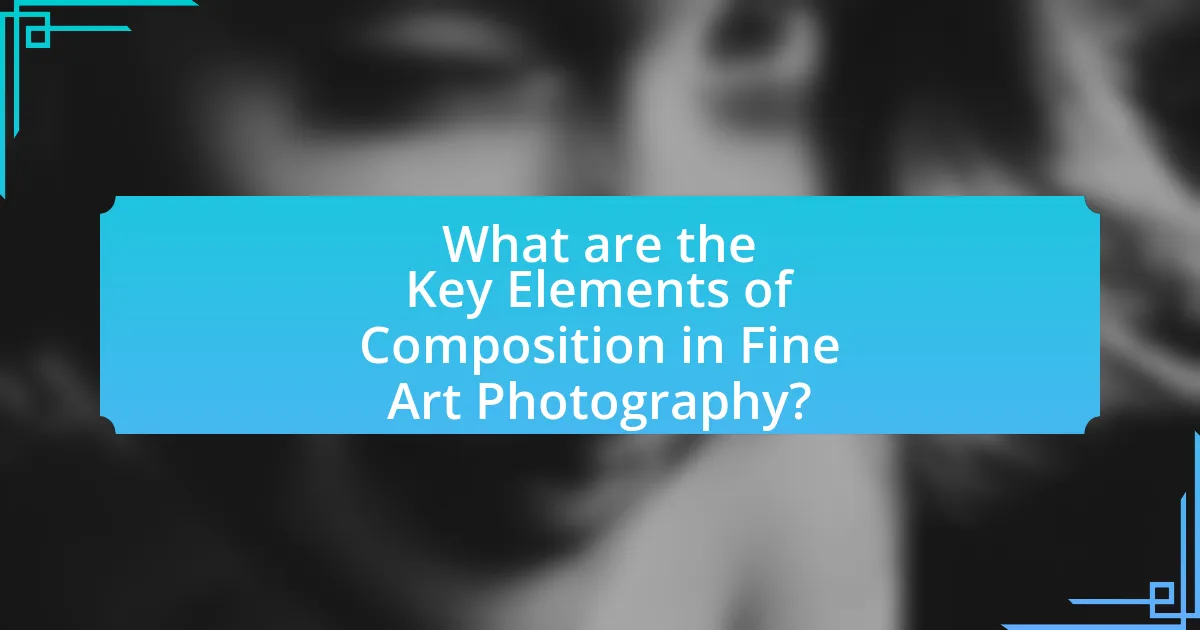
What are the Key Elements of Composition in Fine Art Photography?
The key elements of composition in fine art photography include balance, contrast, focal point, leading lines, and framing. Balance refers to the distribution of visual weight in an image, which can be achieved through symmetrical or asymmetrical arrangements. Contrast enhances visual interest by juxtaposing different elements, such as light and dark or colors. A focal point directs the viewer’s attention to the most important part of the photograph, often achieved through positioning or depth of field. Leading lines guide the viewer’s eye through the image, creating a sense of depth and movement. Framing involves using elements within the scene to create a border around the subject, drawing attention and adding context. These elements are foundational in creating visually striking photographs that engage viewers effectively.
How do lines and shapes contribute to composition?
Lines and shapes are fundamental elements that significantly influence composition in visual art. Lines guide the viewer’s eye, create movement, and establish relationships between different elements within the artwork. For instance, diagonal lines can evoke a sense of dynamism, while horizontal lines often convey stability. Shapes, on the other hand, provide structure and form, allowing artists to create balance and harmony within the composition. The arrangement of shapes can lead to focal points, drawing attention to specific areas of the artwork. Research in visual perception indicates that viewers instinctively follow lines and recognize shapes, which underscores their importance in guiding interpretation and emotional response. Thus, the effective use of lines and shapes is essential for creating visually striking compositions in fine art photography.
What types of lines are most effective in photography composition?
The most effective types of lines in photography composition are leading lines, diagonal lines, and horizontal lines. Leading lines guide the viewer’s eye toward the main subject, creating depth and perspective. Diagonal lines add dynamism and energy to the composition, often making the image feel more engaging. Horizontal lines can evoke a sense of calm and stability, often used in landscape photography to emphasize the horizon. These line types are foundational in visual storytelling, as they help structure the composition and enhance the viewer’s experience.
How can shapes be used to create balance and harmony in images?
Shapes can create balance and harmony in images by establishing visual relationships that guide the viewer’s eye and create a sense of stability. For instance, symmetrical shapes can evoke a feeling of order, while asymmetrical shapes can create dynamic tension that still feels cohesive when arranged thoughtfully. The use of geometric shapes, such as circles and triangles, can lead to focal points that draw attention and enhance the overall composition. Research in visual perception indicates that balanced compositions are more aesthetically pleasing, as demonstrated by studies showing that viewers prefer images with symmetrical arrangements (Leder et al., 2004, “Aesthetic Emotions and Aesthetic Judgments”). Thus, the strategic placement and combination of shapes in an image can significantly influence its visual impact and emotional resonance.
What is the significance of color and light in composition?
Color and light are crucial elements in composition as they influence the mood, depth, and focus of an image. Color can evoke emotions and set the tone, while light shapes the perception of form and texture. For instance, warm colors like red and orange can create feelings of warmth and excitement, whereas cool colors like blue and green can evoke calmness. Additionally, the quality of light, such as soft or harsh, affects how subjects are perceived; soft light can create a gentle atmosphere, while harsh light can produce stark contrasts and drama. Studies in color theory, such as those by Johannes Itten, demonstrate how color combinations can impact visual harmony and viewer engagement, reinforcing the significance of these elements in effective composition.
How does color theory apply to photographic composition?
Color theory significantly influences photographic composition by guiding the use of color to create visual harmony and emotional impact. Photographers utilize concepts such as complementary colors, analogous colors, and color temperature to enhance the aesthetic appeal of their images. For instance, complementary colors, which are opposite each other on the color wheel, can create dynamic contrast and draw attention to focal points in a photograph. Research indicates that color combinations can evoke specific emotions; for example, warm colors like red and orange can stimulate feelings of excitement, while cool colors like blue and green can convey calmness. This understanding of color relationships allows photographers to compose images that resonate with viewers on both visual and emotional levels.
What techniques can be used to manipulate light for better composition?
Techniques to manipulate light for better composition include using natural light, artificial light sources, reflectors, diffusers, and filters. Natural light can be harnessed during golden hour for softer shadows and warmer tones, enhancing the overall aesthetic. Artificial light sources, such as strobes or LED panels, allow for controlled lighting conditions, enabling photographers to create specific moods or highlight details. Reflectors can bounce light onto subjects, filling in shadows and creating a more balanced exposure. Diffusers soften harsh light, reducing contrast and creating a more flattering appearance. Filters, such as polarizers or ND filters, can control glare and exposure, allowing for greater creative freedom in composition. These techniques are widely used in photography to achieve visually striking results.

How can Photographers Improve Their Compositional Skills?
Photographers can improve their compositional skills by studying fundamental principles such as the rule of thirds, leading lines, and framing. Mastery of these techniques allows photographers to create more balanced and engaging images. For instance, the rule of thirds suggests dividing the frame into a grid and placing key elements along these lines or at their intersections, which has been shown to enhance visual interest and guide the viewer’s eye. Additionally, practicing with different perspectives and experimenting with light can further refine compositional abilities, as diverse viewpoints often reveal unique arrangements and focal points.
What practical exercises can enhance compositional understanding?
Practical exercises that can enhance compositional understanding include creating a series of photographs using the rule of thirds, experimenting with leading lines, and practicing framing techniques. The rule of thirds involves dividing the frame into a grid and placing key elements along these lines or at their intersections, which has been shown to create more balanced and engaging images. Leading lines guide the viewer’s eye through the photograph, enhancing depth and perspective, while framing techniques involve using elements within the scene to create a ‘frame’ around the subject, drawing attention to it. Engaging in these exercises allows photographers to develop a more intuitive sense of composition, supported by studies indicating that structured practice leads to improved visual literacy and artistic skills.
How can photographers use framing and perspective to improve composition?
Photographers can use framing and perspective to improve composition by strategically positioning elements within the frame to guide the viewer’s eye and create depth. Framing involves using natural or architectural elements to encase the subject, which enhances focus and adds context. For example, shooting through a doorway or using branches can create a layered effect that draws attention to the main subject. Perspective, on the other hand, refers to the angle and distance from which a photograph is taken, influencing how subjects relate to one another in space. By employing techniques such as low-angle shots or leading lines, photographers can create a sense of scale and dimension, making images more dynamic. Research indicates that effective use of these techniques can significantly enhance visual interest and emotional impact in photography, as evidenced by studies on viewer engagement and perception in visual arts.
What role does practice play in mastering composition techniques?
Practice is essential in mastering composition techniques as it allows photographers to refine their skills, develop an eye for detail, and understand the principles of visual balance. Through consistent practice, individuals can experiment with various compositional elements such as framing, leading lines, and the rule of thirds, which enhances their ability to create visually striking images. Research indicates that deliberate practice leads to improved performance; for instance, a study by Ericsson et al. (1993) highlights that expert-level performance in any field, including photography, is largely a result of sustained and focused practice. Thus, regular engagement with composition techniques not only builds technical proficiency but also fosters creativity and personal style in fine art photography.
What common mistakes should photographers avoid in composition?
Photographers should avoid common mistakes in composition such as neglecting the rule of thirds, failing to consider leading lines, and ignoring the background. Neglecting the rule of thirds can lead to unbalanced images; placing the subject off-center often creates a more engaging composition. Failing to utilize leading lines can result in a lack of depth and direction in the photograph, which diminishes viewer interest. Ignoring the background can introduce distractions that detract from the main subject, ultimately weakening the overall impact of the image. These mistakes can significantly affect the visual appeal and effectiveness of fine art photographs.
How can over-complexity detract from a photograph’s impact?
Over-complexity can detract from a photograph’s impact by overwhelming the viewer and obscuring the main subject. When a photograph contains too many elements or intricate details, it can create confusion, making it difficult for the audience to focus on the intended message or emotion. Research indicates that images with simpler compositions often elicit stronger emotional responses, as they allow viewers to engage more directly with the focal point. For instance, studies in visual perception show that clarity and simplicity enhance recognition and appreciation, reinforcing the idea that a less cluttered image can be more powerful and memorable.
What are the pitfalls of neglecting the background in composition?
Neglecting the background in composition can lead to a disjointed or confusing visual narrative. A poorly considered background may distract from the main subject, diminishing its impact and clarity. For instance, a cluttered or overly busy background can draw attention away from the focal point, making it difficult for viewers to engage with the intended message of the photograph. Additionally, failing to harmonize the background with the subject can result in a lack of cohesion, undermining the overall aesthetic quality of the image. This principle is supported by composition theories, such as the rule of thirds, which emphasize the importance of background elements in enhancing the subject’s prominence and storytelling.
What are some best practices for creating visually striking fine art photographs?
To create visually striking fine art photographs, photographers should focus on strong composition, effective use of light, and thoughtful subject matter. Strong composition involves applying techniques such as the rule of thirds, leading lines, and framing to guide the viewer’s eye and create balance. Effective use of light, including natural and artificial sources, enhances mood and depth, as seen in the works of renowned photographers like Ansel Adams, who mastered the interplay of light and shadow. Thoughtful subject matter, which resonates emotionally or conceptually, can elevate a photograph’s impact, as demonstrated by the evocative imagery of artists like Cindy Sherman. These practices collectively contribute to the creation of compelling fine art photographs.
How can photographers develop a personal style through composition?
Photographers can develop a personal style through composition by consistently applying specific techniques that reflect their unique vision. This involves experimenting with elements such as framing, balance, and the rule of thirds to create distinctive visual narratives. For instance, a photographer might favor asymmetrical compositions to evoke tension or use leading lines to guide the viewer’s eye, thereby establishing a recognizable aesthetic. Research indicates that personal style in photography often emerges from repeated practice and intentional choices, allowing photographers to convey their individual perspectives effectively.
What tips can help in achieving a cohesive visual narrative in photography?
To achieve a cohesive visual narrative in photography, focus on a consistent theme or story throughout your images. This can be accomplished by selecting a specific subject matter, color palette, or style that ties the photographs together. For instance, using a limited color scheme can create harmony and enhance the narrative, as seen in the works of photographers like Gregory Crewdson, who often employs a specific color palette to evoke emotion and context. Additionally, maintaining a similar composition style across images, such as framing or perspective, reinforces the narrative structure. This approach is supported by studies in visual perception, which indicate that viewers are more likely to connect with images that share visual similarities, thus enhancing the overall storytelling experience.












